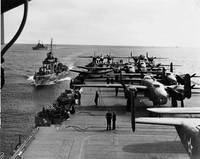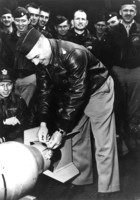December 7, 1941 was a pivotal day in U.S. history. The Japanese naval forces destroyed much of the American battle fleet at Pearl Harbor. This was the beginning of a series of major victories for …
This item is available in full to subscribers.
We have recently launched a new and improved website. To continue reading, you will need to either log into your subscriber account, or purchase a new subscription.
If you are a current print subscriber, you can set up a free website account by clicking here.
Otherwise, click here to view your options for subscribing.
Please log in to continue |
|


December 7, 1941 was a pivotal day in U.S. history. The Japanese naval forces destroyed much of the American battle fleet at Pearl Harbor. This was the beginning of a series of major victories for the Japanese in the South Pacific.
The Americans were losing ground throughout the vast expanse of the Pacific Ocean. This greatly frustrated the American public and there was a clamor calling for a victory of any kind. This was mainly a call for vengeance. President Roosevelt was just as frustrated. He called together his top military advisers asking them to formulate a plan to attack Japan. The most obvious conception was an air strike against the Japanese homeland. However, there were problems with the execution of such an endeavor. First, we had no bases from which to launch such an attack. Second, we didn’t have the airplanes that had the range to operate without those bases. The obvious answer was to launch a strike from one of the American aircraft carriers, which were luckily overlooked by the Japanese military.
After studying several plans of action, the panel chose one offered by Lieutenant Colonel Jimmy Doolittle, one of aviation’s early pioneers, and a noted racing and stunt pilot serving in the Army Air Force (AAF).
Although the U.S. Navy had the aircraft carriers for a bombing mission against Japan, they didn’t have the heavier aircraft needed to carry out the proposal. With his years of flying experience behind him, Doolittle seemed to be the ideal choice to plan and execute this complex undertaking. After reviewing a number of Army Air Force bombers, Doolittle chose the B-25, a rugged twin-engine bomber capable of delivering a 2,000-pound bomb load.
The plan was to have a Navy task force take 15 B-25s as close as possible to the Japanese mainland, roughly 450 miles. There, the bombers would take off from the carrier’s deck on their way to Tokyo. All this required precision planning and training, the biggest challenge being in training the pilots to take off from a 500-foot aircraft carrier deck with a fully loaded bomber designed to take off from a much longer runway. Twenty-four airplanes, including six spares, were specially converted for the mission.
Now the crews had to be chosen. Because this was to be such a dangerous mission, it was decided to call for volunteers. The response was overwhelming. One of those 140 volunteers was a Rhode Island native, Omer Adelard Duquette. Duquette was born on Jan. 25, 1916 in the mill village of Jericho (Arctic) in the town of West Warwick of French-Canadian parents, the second oldest of five brothers and two sisters. Duquette spent his early years in the village of Phenix, where he attended Notre Dame Parochial School. Like Doolittle, he was somewhat of a daredevil. Mechanically inclined, he worked for a time for his Uncle Oscar in Arcand’s Service Center. His friends regarded young Duquette as a brave kid, always taking the lead in any game they played. After a short stint with the Civilian Conservation Corps (CCC), he joined the Army Air Force at the age of 18, eventually rising to the rank of Staff Sergeant. Because of his mechanical ability he was assigned to the maintenance of the squadron’s aircraft.
After being sworn to secrecy, these volunteers started their special training. Each man was trained to perform double duty. Duquette was engineer/gunner. The planes had to be modified with extra fuel tanks, bomb shackles and other changes needed to complete their mission. On March 23, 1942 the 22 planes (including six spares with two left behind) and their crews left Eglin Field, Fla. and arrived safely at McLellan Field, near Sacramento, Calif. At the same time, the aircraft carrier USS Hornet was steaming toward California to rendezvous with Doolittle’s strike force. To the 15 planes selected, a 16th was added as a spare. The only problem that wasn’t quite resolved was where to land the planes after the raid. China seemed the obvious choice, but that option was still unsure.
On April 2, 1942 the task force set sail for their date with destiny.
The first few days were uneventful, but anxiety was mounting. The tension was broken on the 18th when a Japanese patrol boat spotted the task force and presumably alerted the Japanese authorities. The Navy couldn’t risk the loss of an aircraft carrier from a possible enemy attack. This forced Doolittle to launch his planes at a distance of 600 miles from the target instead of the intended 450. Doolittle was first off the carrier with 15 others following. Duquette was in aircraft #12.
Meanwhile Tokyo, after receiving news of an imminent attack, believed the report to be without merit because there were no nearby land bases for the Americans to launch heavy bombers.
At around noon on the 18th Doolittle and his squadron, flying low to escape detection, struck various military targets in five major Japanese cities, including Tokyo. Flying toward China, most of the planes were running out of fuel and were either ditched or crash-landed. Duquette was one of those who landed in China.
A few months later, on June 3, 1942, Duquette volunteered for another dangerous mission near the Burma Road. His luck finally ran out when his plane slammed into the side of a mountain. The plane and the entire crew were never found. Duquette was posthumously awarded many honors, including the Distinguished Flying Cross for gallantry and was also honored by the Chinese government. A monument to Staff Sgt. Omer
Duquette was erected at Phenix Square. Its dedication was attended by General Jimmy Doolittle. This daring and implausible feat, which boosted American morale during a desperate time, was immortalized in the book and movie, “Thirty Seconds Over Tokyo.”
Anthony D’Abrosca of Coventry is a member of the Pawtuxet Valley Preservation and Historical Society and writes a monthly column for its newsletter. He is an Army veteran of World War II who served in the South Pacific.
Comments
No comments on this item Please log in to comment by clicking here